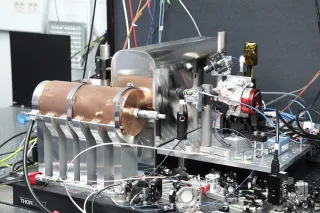Measuring time is a job that requires extreme accuracy: time must remain in sync with the motions of the Earth. The leap year is needed for keeping our calendar in check. Without it, the summer and winter solstices would drift out of their place, and, little by little, so would the seasons. The national time in Finland is measured with an atomic clock located in Otaniemi.
Finland uses a Gregorian calendar, where a year consists of 365 days. This corresponds to the time it takes for the Earth to revolve around the Sun, but not quite exactly. In reality, the Earth's revolution around the Sun lasts 365.242 days. The calendar is corrected with the help of the leap year every four years, except for the years that are exactly divisible by 100. But there is also an exception to an exception, since every fourth century year is a leap year in the calendar, the latest one in 2000.
Another oddity in measuring time is related to changing the clocks in spring and autumn. The use of summer time is based on the EU directive from the year 2000, and it evokes strong emotions for and against. The purpose of summer time is to get the light hours of the day to sensible use. In Finland, this is rather unnecessary – in practice, our winters are dark, and our summers are light. Therefore, the importance of summer time is probably greater in southern Europe.
Official time based on hydrogen atom frequency
The national time of Finland is maintained by VTT's Centre for Metrology MIKES. At VTT MIKES, atomic clocks use microwaves to measure the oscillation of hydrogen atoms at the accuracy of billionths of seconds. "There are similar time laboratories around the world. The International Bureau of Weights and Measures in Paris compares the times given by atomic clocks on a monthly basis and adjusts the Coordinated Universal Time (or UTC), if necessary," says Anders Wallin from MIKES.
"Anyone can synchronise his or her mobile phone or computer to the national time of Finland with the help of our Network Time Protocol, NTP, service , available free of charge. In addition, we offer a direct optic fibre connection to the accurate time of our atomic clock. More and more companies and organisations are showing interest for this service," Wallin points out.
The leap second adjusts the difference to the Earth's rotation speed
In accordance with the International System of Units (SI), instead of hydrogen, the definition of a second is based on the frequency of caesium atom oscillation. "When you compare that to the Earth's rotation around its own axis, you notice that the day is 1–2 milliseconds longer than the 24-hour day measured with atomic clocks. The difference is adjusted with the help of a leap second, as necessary. The latest leap second was added on the last day of 2016.
Time lies behind everything
Accurate measuring of time is important, for example, because the base units of our SI system are dependent on time. Therefore, the measuring of time is reflected upon the measuring of, for example, length, weight and temperature.
Many new technologies, ranging from 5G mobile networks to satellite positioning, are based on accurate time: an error of even a nanosecond in one place may cause a major deviation elsewhere. Many commercial and public services from stock exchange trading to delivery of official documents require accurate timing.






